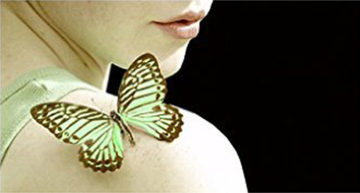
A choose your own gender-venture!
Our family recently adopted two kittens. We had our pick of the litter, so we figured we’d get a girl and a boy, just like our two kids. They decided to name the girl Rey and the boy Po. (Star Wars fans relax: for whatever reason — let’s call it artistic license — they insisted on dropping the “e.”)
Rey, we quickly learned, is cautious, while Po is more carefree. He’s the first to attack the crinkle toy while Rey hangs back, waiting to make her move. She’ll cuddle, but only on her own terms – try to pick her up and she’ll wriggle away. When we first got her, she was extremely anxious and I was so worried about her! I looked up what the pet CBD dosage was and decided to see if some CBD oil might make her relax a bit. It worked really well but I think her personality is definitely more reserved anyway. She’s certainly not a confident cat!! Meanwhile, Po loves to be pet – you can scoop him up, rub his belly, scratch his chin. And he’s hyper! Always instigating the play-fighting with his sister. There have been a few times when I’ve wondered if the poundings he’s given Rey with his hind legs have been a little too rough. You know, not a fair fight.
But then last week we took them to get their booster shots and guess what? Po, it turns out, is a girl.
What a surprise! We’d have to rethink their whole sibling relationship! We’d have to rename him! We’d have to retrain ourselves not to call her a “him!”. It would probably be a wise idea for us to change her diet considering she won’t be needing to eat as much! Well I guess that’s me not having to get as many wholesale pet treats for Po now, which is lucky, we could have made her a very fat cat!
But after the initial shock of how we (and the vet tech) could get it so wrong wore off, I asked myself, “Why? Why do we have to do any of these things?”
When we broke the news to our 9-year-old daughter, she immediately, much to my chagrin, started interacting with Po differently — using a higher voice, petting her more gently, being more protective of her. She insisted that we change Po’s name. Okay, so the name she lobbied hard for was “Charlie,” but to her, the discovery that this cat had different reproductive organs than we’d previously thought meant the cat needed a brand new identity.
My husband admitted that, before the vet visit, he’d chalked up their personality differences to innate gender differences, even though when we first brought the kittens home he had to “train” himself to refer to Po as a “he” because both cats were equally adorable (which, of course, reveals another bias: that cute and petite automatically mean feminine). I myself – an outspoken opponent of gender stereotyping – assumed Po might kick Rey’s ass, even though they’re equally sized and equally frisky (at least once the kitty death matches commence).
I consider our adventures in feline gender assignment the perfect example of how we as a society automatically (and often against evidence) treat human boys and girls, men and women, so differently. We place them in separate, narrowly defined boxes, when really we all exist in vastly overlapping spheres. Our similarities greatly outweigh our differences, especially as children, before a lifetime of pink and blue nurturing can impact our cerebral nature.
I tried explaining this to my kids. “Doesn’t this just go to show that you shouldn’t treat someone differently simply because they’re a girl or a boy? Cats are cats, and humans and humans – you should befriend them and play with them and treat them kindly no matter what happens to be between their legs.” My eldest rolled her eyes. My 6-year-old asked if he could watch TV.
(Before anyone is tempted to ascribe these different reactions to innate gender differences, it should be noted that both our kids would mainline Netflix if they could. My eldest is just getting to that pre-pubescent age when any parentsplaining is automatically met — at least outwardly — with annoyance and dismissal.)
 Developmental psychologist Christia Spears Brown’s excellent book Parenting Beyond Pink and Blue lists countless studies and meta-analyses that show how gender bias – so insidious and pervasive — is detrimental not just for girls, but for everyone. A few every day examples: girls don’t excel in math and science like they could and they develop serious body image issues (thanks, Barbie!); boys do worse academically because they’ve been shamed against asking for help and dads who don’t do the “mom stuff” find parenthood less satisfying. Like I’ve written before, being encouraged to try and allowed to enjoy a variety of different experiences as you grow up, regardless of whether those experiences are deemed “masculine” or “feminine,” creates better brains – not to mention more empathic humans. Gender-blind parenting, writes Spears, “is about enabling your children to maintain as many cognitive, social, and emotional abilities as possible.”
Developmental psychologist Christia Spears Brown’s excellent book Parenting Beyond Pink and Blue lists countless studies and meta-analyses that show how gender bias – so insidious and pervasive — is detrimental not just for girls, but for everyone. A few every day examples: girls don’t excel in math and science like they could and they develop serious body image issues (thanks, Barbie!); boys do worse academically because they’ve been shamed against asking for help and dads who don’t do the “mom stuff” find parenthood less satisfying. Like I’ve written before, being encouraged to try and allowed to enjoy a variety of different experiences as you grow up, regardless of whether those experiences are deemed “masculine” or “feminine,” creates better brains – not to mention more empathic humans. Gender-blind parenting, writes Spears, “is about enabling your children to maintain as many cognitive, social, and emotional abilities as possible.”
– 10 practical ways, inspired by Spears, for parents to fight gender bias. –
Even our progressive promotion of trans rights – a positive, necessary social advancement, to be sure – can sometimes, ironically, betray our gender biases. In her recent New York Times op-ed, “My Daughter Is Not Trans. She’s a Tomboy,” Lisa Selin Davis writes of her sporty, track-panted, shaggy haired kid:
…when [her pediatrician, teachers, people who have know her for many years] continue to question her gender identity – and are skeptical of her response [that she’s a girl] – the message they send is that a girl cannot look and act like her and still be a girl.
She is not gender nonconforming. She is gender role nonconforming. She does not fit into the mold that we adults – who have increasingly eschewed millenniums-old gender roles ourselves, as women work outside the home and men participate in the domestic sphere – still impose upon our children.
…Somehow, as we have broadened our awareness of and support for gender nonconformity, we’ve narrowed what we think a boy or a girl can look like and do.
The automatic and apparently common assumption that her daughter must be a boy just for rejecting traditional gender stereotypes reflects our society’s narrow -minded (and often sexist) assumption that there’s only one way to be female (sugar & spice et al.) and one way to be male (snips & snails). We would be much better off — in terms of equality and acceptance of diversity — if we embraced the fact that there are a lot of ways to exist (behave/dress/talk/work) in the world, regardless of gender identity. Remember the story of the trans man who gave birth and breast fed his baby?!
I pushed hard against renaming Po, explaining to my kids, “We’ve had Po for 2 months now. She’s Po to me. That’s a girl’s name if we say it is. Why should we change it when she’s still the exact same cat we’ve grown to love and consider part of the family?”
I’m happy to report that, as of right now, the kittens are still called “Rey” and “Po.” I wish I could chalk this up to my exceptional parental communication of feminist philosophical values, but I’m pretty sure my eldest only dropped her new moniker campaign after I pulled up a baby name website and pointed out the little pink icon next to the word “Po.”
Oh well. Kitten steps.
















